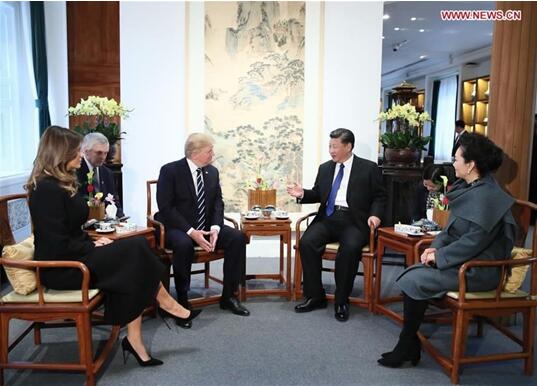Digital Forbidden City: Sensors, online promotion and ticketing
The Internet didn't kill the museums. Instead, it is now the most powerful weapon for museum managers to attract young visitors.
Chinese President Xi Jinping (3rd R) and his wife Peng Liyuan (1st R), and US President Donald Trump (3rd L) and his wife Melania Trump (1st L) chat during an informal afternoon tea in the Baoyun Building of the Palace Museum in Beijing on Nov. 8. [Photo/Xinhua]
That is true even for the Forbidden City, whose official name is the Palace Museum, in Beijing. The used-to-be royal family residence has in recent years become a star among Chinese Internet users, as its managers seek to satisfy a younger audience.
Some people would have never thought that an old-fashioned museum can become a giant meme machine.
And maybe not just the youngsters, since Chinese President Xi Jinping and his US counterpart Donald Trump visited the museum together earlier this month.
The middle-aged have also been moved by a documentary series showing how craftsmen repair relics in the thousand-year-old treasure house.
Sorry, no paper tickets
The museum is very focused on digitization as it closed the physical ticket office last month and started selling all tickets online.
"There were less than 10 percent of people buying digital tickets in 2012," Shan Jixiang, the chief curator of the Palace Museum told his audience at a symposium about digital museums on Tuesday in the Forbidden City.
"But the number kept increasing. In July 2017 it's already 70 percent. We thought it's time to get completely digital."
Shan described how nervous he was on the first day without paper tickets.
"Although the door of the ticket office was shut, the sellers were still on-position in case anything went wrong," he said."Fortunately they just sat there waiting for the whole day."
City of sensors
For more than 500 years, the Forbidden City was the seat of China's supreme power. Hence the palace is recognized by the United Nation Educational, Scientific and Cultural Organization (UNESCO) as a world heritage site.
It is also a museum that can attract a maximum of 160,000 visitors a day. But how can the managers protect the attraction from natural and non-natural damage in the face of this huge human traffic?
The answer is in technology, according to Shan.
"We resorted to hi-tech quite early in the museum world," he said."Sensors are hidden everywhere to monitor the health of buildings and relics."
He demonstrated the central control system in the museum's office. The system can not only display real-time status of the heritage, but also automatically generate yearly report papers.
With the massive data collected, the managers concluded that the optimum number of visitors should actually be 80,000.
As a result, the online ticket house will shut itself down when the limit is reached.
Remote sensing can also help with the restoration work. Modern technology allows engineers to do a full scan of an object without a single touch, and provide massive data for craftsmen to find the best way to restore a relic to its past glory.
"Technology has given our museum a new life," Shan concluded.
